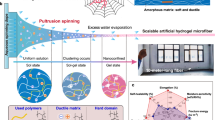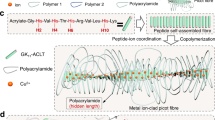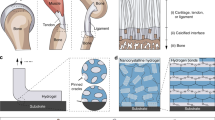Abstract
Natural load-bearing materials such as tendons have a high water content of about 70 per cent but are still strong and tough, even when used for over one million cycles per year, owing to the hierarchical assembly of anisotropic structures across multiple length scales1. Synthetic hydrogels have been created using methods such as electro-spinning2, extrusion3, compositing4,5, freeze-casting6,7, self-assembly8 and mechanical stretching9,10 for improved mechanical performance. However, in contrast to tendons, many hydrogels with the same high water content do not show high strength, toughness or fatigue resistance. Here we present a strategy to produce a multi-length-scale hierarchical hydrogel architecture using a freezing-assisted salting-out treatment. The produced poly(vinyl alcohol) hydrogels are highly anisotropic, comprising micrometre-scale honeycomb-like pore walls, which in turn comprise interconnected nanofibril meshes. These hydrogels have a water content of 70–95 per cent and properties that compare favourably to those of other tough hydrogels and even natural tendons; for example, an ultimate stress of 23.5 ± 2.7 megapascals, strain levels of 2,900 ± 450 per cent, toughness of 210 ± 13 megajoules per cubic metre, fracture energy of 170 ± 8 kilojoules per square metre and a fatigue threshold of 10.5 ± 1.3 kilojoules per square metre. The presented strategy is generalizable to other polymers, and could expand the applicability of structural hydrogels to conditions involving more demanding mechanical loading.
This is a preview of subscription content, access via your institution
Access options
Access Nature and 54 other Nature Portfolio journals
Get Nature+, our best-value online-access subscription
$29.99 / 30 days
cancel any time
Subscribe to this journal
Receive 51 print issues and online access
$199.00 per year
only $3.90 per issue
Buy this article
- Purchase on Springer Link
- Instant access to full article PDF
Prices may be subject to local taxes which are calculated during checkout




Similar content being viewed by others
Data availability
The data that support the findings of this study are available from the corresponding author on reasonable request.
References
Maganaris, C. N. & Paul, J. P. In vivo human tendon mechanical properties. J. Physiol. (Lond.) 521, 307–313 (1999).
Gu, L., Jiang, Y. & Hu, J. Scalable spider-silk-like supertough fibers using a pseudoprotein polymer. Adv. Mater. 31, 1904311 (2019).
Hong, S. et al. 3D printing of highly stretchable and tough hydrogels into complex, cellularized structures. Adv. Mater. 27, 4034–4040 (2015).
Xiang, C. et al. Stretchable and fatigue-resistant materials. Mater. Today 34, 7–16 (2020).
Huang, Y. et al. Energy-dissipative matrices enable synergistic toughening in fiber reinforced soft composites. Adv. Funct. Mater. 27, 1605350 (2017).
Zhang, H. et al. Aligned two- and three-dimensional structures by directional freezing of polymers and nanoparticles. Nat. Mater. 4, 787–793 (2005).
Zhang, H. Ice Templating and Freeze-Drying for Porous Materials and their Applications (Wiley-VCH, 2018).
Qin, H., Zhang, T., Li, N., Cong, H. P. & Yu, S. H. Anisotropic and self-healing hydrogels with multi-responsive actuating capability. Nat. Commun. 10, 2202 (2019).
Mredha, M. T. I. et al. Anisotropic tough multilayer hydrogels with programmable orientation. Mater. Horiz. 6, 1504–1511 (2019).
Mredha, M. T. I. et al. A facile method to fabricate anisotropic hydrogels with perfectly aligned hierarchical fibrous structures. Adv. Mater. 30, 1704937 (2018).
Wegst, U. G. K., Bai, H., Saiz, E., Tomsia, A. P. & Ritchie, R. O. Bioinspired structural materials. Nat. Mater. 14, 23–36 (2015).
Sun, J.-Y. et al. Highly stretchable and tough hydrogels. Nature 489, 133–136 (2012).
Gong, J. P., Katsuyama, Y., Kurokawa, T. & Osada, Y. Double-network hydrogels with extremely high mechanical strength. Adv. Mater. 15, 1155–1158 (2003).
Hu, X., Vatankhah-Varnoosfaderani, M., Zhou, J., Li, Q. & Sheiko, S. S. Weak hydrogen bonding enables hard, strong, tough, and elastic hydrogels. Adv. Mater. 27, 6899–6905 (2015).
Lin, P., Ma, S., Wang, X. & Zhou, F. Molecularly engineered dual-crosslinked hydrogel with ultrahigh mechanical strength, toughness, and good self-recovery. Adv. Mater. 27, 2054–2059 (2015).
He, Q., Huang, Y. & Wang, S. Hofmeister effect-assisted one step fabrication of ductile and strong gelatin hydrogels. Adv. Funct. Mater. 28, 1705069 (2018).
Lin, S. et al. Anti-fatigue-fracture hydrogels. Sci. Adv. 5, eaau8528 (2019).
Bai, R., Yang, J., Morelle, X. P. & Suo, Z. Flaw-insensitive hydrogels under static and cyclic loads. Macromol. Rapid Commun. 40, 1800883 (2019).
Lin, S., Liu, J., Liu, X. & Zhao, X. Muscle-like fatigue-resistant hydrogels by mechanical training. Proc. Natl Acad. Sci. USA 116, 10244–10249 (2019).
Illeperuma, W. R. K., Sun, J. Y., Suo, Z. & Vlassak, J. J. Fiber-reinforced tough hydrogels. Extreme Mech. Lett. 1, 90–96 (2014).
Lin, S. et al. Design of stiff, tough and stretchy hydrogel composites via nanoscale hybrid crosslinking and macroscale fiber reinforcement. Soft Matter 10, 7519–7527 (2014).
King, D. R., Okumura, T., Takahashi, R., Kurokawa, T. & Gong, J. P. Macroscale double networks: design criteria for optimizing strength and toughness. ACS Appl. Mater. Interfaces 11, 35343–35353 (2019).
Fan, H. & Gong, J. P. Fabrication of bioinspired hydrogels: challenges and opportunities. Macromolecules 53, 2769–2782 (2020).
Zhao, X. Multi-scale multi-mechanism design of tough hydrogels: building dissipation into stretchy networks. Soft Matter 10, 672–687 (2014).
Wang, Z. et al. Stretchable materials of high toughness and low hysteresis. Proc. Natl Acad. Sci. USA 116, 5967–5972 (2019).
Iwaseya, M., Watanabe, M., Yamaura, K., Dai, L. X. & Noguchi, H. High performance films obtained from PVA/Na2SO4/H2O and PVA/CH3COONa/H2O systems. J. Mater. Sci. 40, 5695–5698 (2005).
Zhang, Y. & Cremer, P. S. Interactions between macromolecules and ions: the Hofmeister series. Curr. Opin. Chem. Biol. 10, 658–663 (2006).
van de Witte, P., Dijkstra, P. J., Van Den Berg, J. W. A. & Feijen, J. Phase separation processes in polymer solutions in relation to membrane formation. J. Membr. Sci. 117, 1–31 (1996).
Lake, G. J. & Thomas, A.G. The strength of highly elastic materials. Proc. R. Soc. A 300, 108–119 (1967).
Kinloch, A. J. & Young, R. J. (eds) Fracture Behaviour of Polymers (Springer Science & Business Media, 1984).
Johnston, I. D., McCluskey, D. K., Tan, C. K. L. & Tracey, M. C. Mechanical characterization of bulk Sylgard 184 for microfluidics and microengineering. J. Micromech. Microeng. 24, 035017 (2014).
Wood, L. A. Uniaxial extension and compression in stress-strain relations of rubber. Rubber Chem. Technol. 51, 840–851 (1978).
Ebrahimi, D. et al. Silk – its mysteries, how it is made, and how it is used. ACS Biomater. Sci. Eng. 1, 864–876 (2015).
Long, R. & Hui, C. Y. Fracture toughness of hydrogels: measurement and interpretation. Soft Matter 12, 8069–8086 (2016).
Jiang, Z. GIXSGUI: a MATLAB toolbox for grazing-incidence X-ray scattering data visualization and reduction, and indexing of buried three-dimensional periodic nanostructured films. J. Appl. Cryst. 48, 917–926 (2015).
Peppas, N. A. & Merrill, E. W. Differential scanning calorimetry of crystallized PVA hydrogels. J. Appl. Polym. Sci. 20, 1457–1465 (1976).
Acknowledgements
This research was supported by NSF CAREER award 1724526, AFOSR awards FA9550-17-1-0311, FA9550-18-1-0449 and FA9550-20-1-0344, and ONR awards N000141712117 and N00014-18-1-2314. X.Z. acknowledges Shanghai Municipal Government 18JC1410800 and National Natural Science Foundation of China 51690151. This research used resources of the Advanced Photon Source, a US Department of Energy (DOE) Office of Science User Facility, operated for the DOE Office of Science by Argonne National Laboratory under contract number DE-AC02-06CH11357.
Author information
Authors and Affiliations
Contributions
M.H., S.W. and X.H. conceived the concept. X.H. supervised the project. M.H., S.W., Z.C. and Y.Z. conducted the experiments. J.S. and H.Z. helped with the WAXS and SAXS measurements. M.H., S.W. and X.H. wrote the manuscript. All authors contributed to the analysis and discussion of the data.
Corresponding author
Ethics declarations
Competing interests
The authors declare no competing interests.
Additional information
Peer review information Nature thanks Jiaxi Cui, Sylvain Deville and the other, anonymous, reviewer(s) for their contribution to the peer review of this work.
Publisher’s note Springer Nature remains neutral with regard to jurisdictional claims in published maps and institutional affiliations.
Extended data figures and tables
Extended Data Fig. 1 Micro- and nanostructures and stress–strain curves of PVA hydrogels fabricated by different methods and their corresponding fracture energies and critical strains.
a, ‘DF + Salting out’ denotes a hydrogel prepared by directional freezing of a 5% PVA solution and salting out in 1.5 M sodium citrate solution for 24 h. b, ‘F + Salting out’ represents a hydrogel prepared by non-directional freezing of a 5% PVA solution in the fridge and salting out in 1.5 M sodium citrate solution for 24 h. c, ‘DFT-3 cycle’ denotes a hydrogel prepared by directional freezing and thawing of a 5% PVA solution for three cycles. d, ‘FT-3 cycle’ indicates a hydrogel prepared by non-directional freezing in the fridge and thawing of a 5% PVA solution for three cycles. e, ‘Chemical Crosslinking’ represents a hydrogel prepared by mixing 0.5% glutaraldehyde and 0.5% hydrochloric acid into a 5% PVA solution for gelation. f, Salting out resulted in non-gelation. Only weak globules of loose and random nanofibrils were made by directly adding a 1.5 M sodium citrate solution into a 5% PVA solution. Panels a–c are the same as Fig. 3a–c.
Extended Data Fig. 3 Fatigue test of HA-20PVA hydrogels.
a, Fatigue threshold of HA-20PVA. When loading above the threshold energy release rate (ε = 400%), the crack propagates slowly. N, number of cycles. b, Validation of fatigue threshold with an energy release rate slightly lower than the fatigue threshold. No crack propagation or failure was observed for 30,000 loading cycles.
Extended Data Fig. 4 Water content and fracture energy of the HA-PVA hydrogels.
a, Water content of HA-xPVA hydrogels for x = 2, 5, 10 and 20. The error bars (1 s.d. from five measured samples) were obtained from five measured samples with standard deviations of 1.72%, 2.29%, 2.69% and 2.43% for x = 2, 5, 10 and 20, respectively. b, Fracture energy of HA-xPVA hydrogels, x = 2, 5, 10 and 20, measured by pure shear tests. The error bars (1 s.d. from five measured samples) were obtained from five measured samples with standard deviations of 0.16, 4.83, 5.44 and 5.62 kJ m−2 for x = 2, 5, 10 and 20, respectively.
Extended Data Fig. 5 HA-alginate hydrogels compared with calcium-alginate hydrogels.
a, Photograph of HA-5alginate hydrogel. b, Tensile stress–strain curve of a HA-5alginate hydrogel compared to that of a regular calcium-alginate hydrogel. Scale bar, 5 mm.
Supplementary information
Supplementary Information
This file includes a list of materials, Supplementary Text, Supplementary References, Supplementary Figs. 1–13, Supplementary Tables 1–3 and full captions for Videos 1 to 4.
Video 1
Tensile loading of HA-5PVA dog-bone shaped hydrogel specimen.
Video 2
Tensile loading of HA-5PVA hydrogel with pre-made crack.
Video 3
Tensile loading of HA-20PVA hydrogel with pre-made crack.
Video 4
Tensile loading of 5PVA hydrogel prepared by non-directional freezing and salting out with pre-made crack.
Rights and permissions
About this article
Cite this article
Hua, M., Wu, S., Ma, Y. et al. Strong tough hydrogels via the synergy of freeze-casting and salting out. Nature 590, 594–599 (2021). https://doi.org/10.1038/s41586-021-03212-z
Received:
Accepted:
Published:
Issue Date:
DOI: https://doi.org/10.1038/s41586-021-03212-z
This article is cited by
-
A bio-based nanofibre hydrogel filter for sustainable water purification
Nature Sustainability (2024)
-
Bioinspired structural hydrogels with highly ordered hierarchical orientations by flow-induced alignment of nanofibrils
Nature Communications (2024)
-
Nanoconfined polymerization limits crack propagation in hysteresis-free gels
Nature Materials (2024)
-
Biomimetic Bouligand chiral fibers array enables strong and superelastic ceramic aerogels
Nature Communications (2024)
-
3D printable strong and tough composite organo-hydrogels inspired by natural hierarchical composite design principles
Nature Communications (2024)
Comments
By submitting a comment you agree to abide by our Terms and Community Guidelines. If you find something abusive or that does not comply with our terms or guidelines please flag it as inappropriate.



